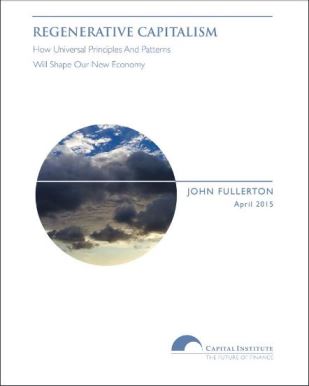John Fullerton is the founder and president of Capital Institute, and a recognized New Economy thought leader and public speaker. He is also an active impact investor through his Level 3 Capital Advisors. He is also serving as a Senior Advisor to the 2016 Fuller Challenge.
In April of 2015, he published a report titled “REGENERATIVE CAPITALISM: How Universal Principles And Patterns Will Shape Our New Economy“.
Here are a few of the report’s conclusions about what a regenerative economy might look like:
- The planet’s degraded ecosystems are restored to highest functionality. This begins with the natural carbon sinks (natural systems that absorb carbon) we know how to manage: the grasslands and forests.
- Once financial and material capital are sufficient to meet basic human needs, creating social capital within community and restoring natural capital in the world are valued above acquiring more financial capital. “Success” is redefined beyond material wealth, power, and fame. Individuals at a deep personal level experience a shift in mindset away from separation and scarcity to one of connectedness and abundance.
- Environmentalists and social justice advocates work together rather than at odds on strategies that restore both ecological and social health, both essential to true human prosperity and interdependence.
- The financial services industry has restored the robust and more distributed circulation of money and credit. Financial wealth is less concentrated in the speculative centers of Wall Street and London, and becomes more broadly distributed directly into productive enterprises in the real economy at local, regional, and global scales. Economies exhibit a more diverse and more decentralized array of financial services firms, and even currency systems, improving money circulation in the process.
- Policymakers restore a healthy market-system balance between systemic efficiency and systemic resilience by rebuilding resilience that has been destroyed and restraining the excessive power of “economies of scale” where necessary. Examples of financial policy initiatives that are aligned with the latter goal include excess capital buffers for “too big to fail” banks as discussed above, a financial transaction tax to create a feedback loop that discourages excessive speculation, and positive incentives that encourage long-term investment in the things we need, beginning with investments that will drive the transition of our energy system away from fossil fuels.
- Like all vibrant, long-lived systems, a Regenerative Economy must be designed to work as an integrated whole.

